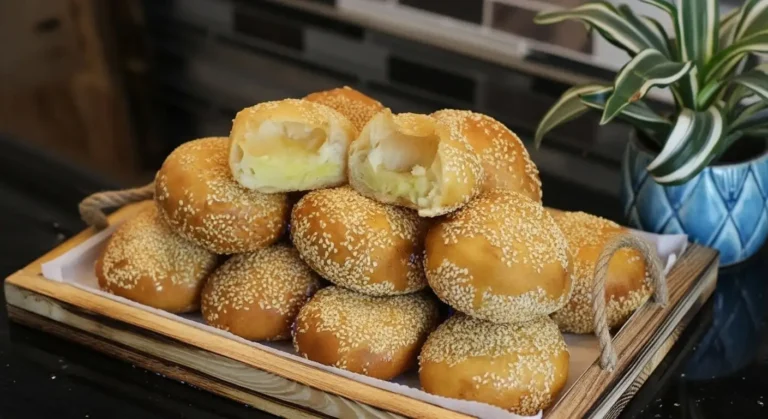Bánh Tiêu (pronounced banh tee-ew) is one of Vietnam’s most beloved street food snacks. Often referred to as a “Vietnamese hollow donut” or “sesame beignet,” this deep-fried pastry is recognized by its signature puffed, hollow center and a generous coating of toasted sesame seeds. Simple in ingredients but magical in texture, Bánh Tiêu offers a delightful balance of subtle sweetness, nutty aroma, and a satisfyingly chewy-crispy bite.

The Basics of Bánh Tiêu
What is it?
Bánh Tiêu is a deep-fried pastry made from a yeast-leavened dough of wheat flour, sugar, salt, and baking powder. Before frying, the dough is flattened into a disc and coated with white sesame seeds.
The Magic (The Puff):
The defining characteristic of Bánh Tiêu is its hollow, balloon-like interior. When dropped into hot oil, the moisture inside the dough rapidly turns into steam, causing the pastry to puff up dramatically like a ball. This creates a beautifully golden, crispy shell and an empty, light-as-air core.
Flavor and Texture:
Flavor: It is subtly sweet—much less sweet than a typical Western donut—with a noticeable nutty aroma from the sesame seeds.
Texture: The exterior is crispy and golden, while the inside is soft, chewy, and tender, often described as having a brioche-like or “QQ” (chewy) consistency despite being hollow.
Origin:
It is widely believed that Bánh Tiêu has ancient Chinese origins, similar to the Chinese youtiao (fried dough crullers) or shāo bǐng variations, but it has been thoroughly adopted and transformed into a unique Vietnamese specialty. It is enjoyed as a convenient snack or light breakfast/afternoon treat.
Ways to Enjoy and Varieties of Bánh Tiêu
While the classic Bánh Tiêu remains consistently delicious, its versatility as a “hollow bread” allows for various popular consumption styles, turning it into a carrier for other fantastic Vietnamese flavors.
The Traditional Way (Plain):
The simplest and most classic method is eating the Bánh Tiêu fresh, hot, and unadorned. The focus is purely on the warm, crispy, slightly sweet dough and the nutty sesame seeds.
Bánh Tiêu Kẹp Xôi (Stuffed with Sticky Rice):
This is a famous and hearty street food combination, especially for breakfast. The hollow donut is sliced open like a pita pocket and stuffed with warm, sweet sticky rice (Xôi), often colored with turmeric (yellow) or flavored with sweet mung bean paste. The contrasting textures (crispy, chewy dough vs. soft, sticky rice) make this an unforgettable “sandwich.”
Bánh Tiêu Kẹp Bánh Bò (Stuffed with Honeycomb Cake):
A combination popular in the South, the Bánh Tiêu is filled with pieces of Bánh Bò (Vietnamese Honeycomb Cake). The crispy donut shell holds the soft, spongy, and slightly milky Bánh Bò, creating a delightful contrast.
Modern and Dessert Fillings:
The hollow nature of the donut makes it an excellent vessel for rich, sweet fillings like green bean (mung bean) paste, durian cream (a favorite for durian lovers), or even pork floss (chà bông) for a salty-sweet savory note.

How to Eat Bánh Tiêu Like a Local
Bánh Tiêu is the quintessential grab-and-go street food.
Eat It Warm: It is absolutely best when eaten immediately after it comes out of the fryer, while the shell is still shatteringly crispy and the interior is soft and steamy. Street vendors typically fry them on demand.
Pair with Coffee: As an energizing morning or afternoon snack, Bánh Tiêu pairs perfectly with a Vietnamese coffee, such as a Cà Phê Sữa Đá (Iced Coffee with Condensed Milk) or a simple hot tea.
Use as a Sandwich: When eating the Kẹp Xôi or Kẹp Bánh Bò variations, the Bánh Tiêu is meant to be held and eaten with your hands, savoring the richness of the filling against the texture of the doughnut.
Dipping (Optional): While delicious plain, some modern variations or personal preferences might include dipping pieces of the Bánh Tiêu into condensed milk for extra sweetness.
Regional Differences: North, Central, and South
Bánh Tiêu is widely popular throughout Vietnam, so the core product (the hollow, sesame-crusted fried dough) remains fundamentally the same. The regional differences are mostly found in how it is served and the preferred accompaniments, which align with each region’s general flavor profile:
| Region | Regional Characteristics | Key Bánh Tiêu Distinctions |
|---|---|---|
| Northern Vietnam (Hanoi) | Known for subtle, balanced flavors, and less sweetness. Focus on simplicity. | Often enjoyed as is, warm and plain, or paired with a clear, hot tea or coffee. The dough itself might be slightly less sweet than in the South. |
| Central Vietnam (Hue, Da Nang, Hoi An) | Known for complex, sometimes spicier, and meticulously presented food. | Bánh Tiêu is sold everywhere as a popular street snack. It is commonly eaten plain or in simple stuffed varieties, often alongside other street Bánh items. Its taste serves as a neutral, comforting contrast to the region's generally bolder dishes. |
| Southern Vietnam (Ho Chi Minh City) | Known for a preference for sweetness and a dynamic mix of flavors and ingredients. | This is where the most creative combinations are found, most notably the popular and hearty Bánh Tiêu Kẹp Xôi (stuffed with sweet sticky rice) and Bánh Tiêu Kẹp Bánh Bò. The dough itself may also have a slightly richer, sweeter profile to appeal to the Southern palate. |




